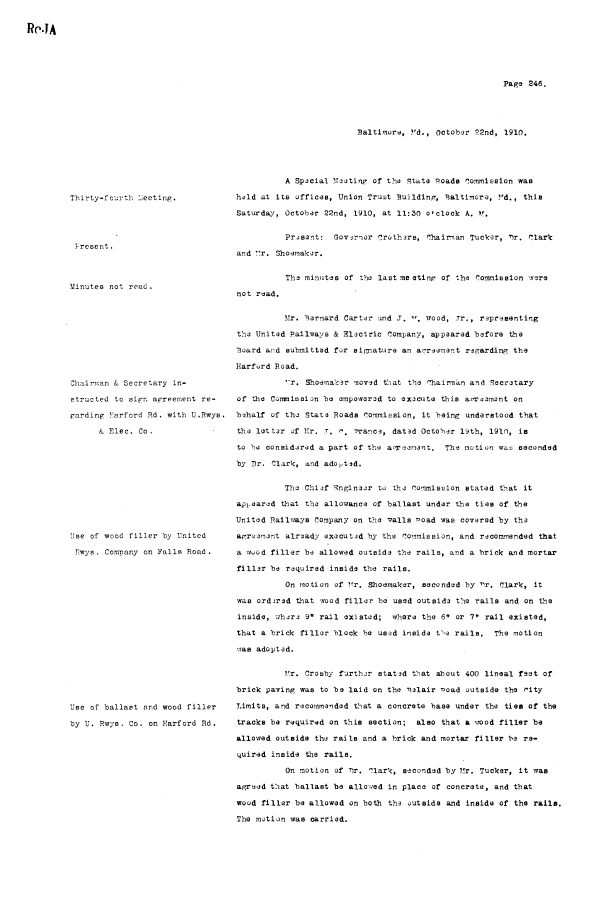 |
||||
|
STATE ROADS COMMISSION (Minutes) Liber 1, 1908-1913 MSA SE3-1 Image No: 14677-0246 Enlarge and print image (54K) |
 |
||||
|
STATE ROADS COMMISSION (Minutes) Liber 1, 1908-1913 MSA SE3-1 Image No: 14677-0246 Enlarge and print image (54K) |
| Ro-TA Page 246. Baltimore, ?'d., October 52nd, 1910. Thirty-fourth J.iecting. I-'re sent. Minutes not read . A Special ?'a<3ting of tha State "Roads Commission was held at its offices, Union Trust Building, "Baltimore, I'd., this Saturday, October 22nd, 1910, at 11:30 o'clock A. V. Present: Governor Crothars, Chairman Tucker, "Hr. Clark and T'r. Shoemaker. Tha minutes of tha last me eting of the Commission were not read. Cliairrr.an & Secretary instructed to sipn agreement re- Mr. Barnard Carter and J. rr. TTood, Jr., representing the United Railways & Electric Company, appeared before the Board and submitted for signature an agreement regarding tha Harfurd Road. 7'r. Shoemaker moved that the Chairman and Secretary of the Commission be empowered to execute this apreamant on parding Karford Rd. with U.Rwys. "behalf of the State Roads Commission, it being understood that & Elec. Co. Use of wood filler by United Rwys. Company on Falls Road. Use of ballast and wood filler by U. Rwys. Co. on Karford Rd. the letter of Ur. j. r>t ^rance, dated October 19th, 1910, is to l:>e considered a part of the a-TS orient. The motion was seconded by Dr. Clark, and adopted. The Chief Engineer to the Commission stated that it api-eared that the allowance of ballast under the ties of the United Railways Company on the Trails Poad was covered by the agreement already executed by the Commission, and recommended that a wood filler be allowed outside the rails, and a brick and mortar filler be required inside the rails. On motion of TTr. Shoemaker, seconded by T. Clark, it was ordered that wood filler be used outside the rails and on the inside, v/here 9" rail existed; where the 6" or 7" rail existed, that a brick filler "block "be used inside t"'e rails. The motion v/as adopted. Mr. Crosby further stated that about 400 lineal faet of brick paving was to be laid on the ^elair t>oad outside the r-ity Limits, and recommended that a concrete base under the ties of the tracks be required on this section; also that a wood filler be allowed outside the rails and a brick and mortar filler be required inside the rails. On motion of T)r. Clark, seconded by Mr. Tucker, it was agreed that ballast be allov;ed in place of concrete, and that wood filler be allowed on both the outside and inside of the rails. The motion was carried. |